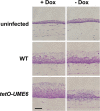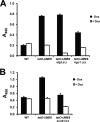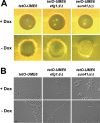Expression of UME6, a key regulator of Candida albicans hyphal development, enhances biofilm formation via Hgc1- and Sun41-dependent mechanisms
- PMID: 23223035
- PMCID: PMC3571304
- DOI: 10.1128/EC.00163-12
Expression of UME6, a key regulator of Candida albicans hyphal development, enhances biofilm formation via Hgc1- and Sun41-dependent mechanisms
Abstract
Biofilm formation is associated with the ability of Candida albicans, the major human fungal pathogen, to resist antifungal therapies and grow on tissues, catheters, and medical devices. In order to better understand the relationship between C. albicans morphology and biofilm formation, we examined biofilms generated in response to expression of UME6, a key filament-specific transcriptional regulator. As UME6 levels rise, C. albicans cells are known to transition from yeast to hyphae, and we also observed a corresponding increase in the level of biofilm formation in vitro. In addition to forming a biofilm, we observed that a C. albicans strain expressing constitutive high levels of UME6 promoted tissue invasion in a reconstituted human three-dimensional model of oropharyngeal candidiasis. Confocal microscopy indicated that both the top and bottom layers of the biofilm generated upon high-level constitutive UME6 expression consist primarily of hyphal cells. UME6-driven biofilm formation was reduced upon deletion of Hgc1, a cyclin-related protein important for hyphal development, as well as Sun41, a putative cell wall glycosidase. Constitutive high-level UME6 expression was also able to completely bypass both the filamentation and biofilm defects of a strain deleted for Efg1, a key transcriptional regulator of these processes. Finally, we show that both Sun41 and Efg1 affect the ability of UME6 to induce certain filament-specific transcripts. Overall, these findings indicate a strong correlation between increased C. albicans hyphal growth and enhanced biofilm formation and also suggest functional relationships between UME6 and other regulators of biofilm development.
Figures








References
-
- Odds FC. 1988. Candida and candidosis. Baillière Tindall, London, United Kingdom
-
- Beck-Sague C, Jarvis WR. 1993. Secular trends in the epidemiology of nosocomial fungal infections in the United States, 1980-1990. National Nosocomial Infections Surveillance System. J. Infect. Dis. 167:1247–1251 - PubMed
-
- Edmond MB, Wallace SE, McClish DK, Pfaller MA, Jones RN, Wenzel RP. 1999. Nosocomial bloodstream infections in United States hospitals: a three-year analysis. Clin. Infect. Dis. 29:239–244 - PubMed
-
- Wisplinghoff H, Bischoff T, Tallent SM, Seifert H, Wenzel RP, Edmond MB. 2004. Nosocomial bloodstream infections in US hospitals: analysis of 24,179 cases from a prospective nationwide surveillance study. Clin. Infect. Dis. 39:309–317 - PubMed
Publication types
MeSH terms
Substances
Grants and funding
- UL 1RR025767/RR/NCRR NIH HHS/United States
- T32 DE014318/DE/NIDCR NIH HHS/United States
- T32DE14318-07/DE/NIDCR NIH HHS/United States
- UL1 RR025767/RR/NCRR NIH HHS/United States
- F31DE020214-03/DE/NIDCR NIH HHS/United States
- UL1 TR000149/TR/NCATS NIH HHS/United States
- R01 AI083344/AI/NIAID NIH HHS/United States
- UL1 TR001120/TR/NCATS NIH HHS/United States
- F31 DE020214/DE/NIDCR NIH HHS/United States
- R21 AI080930/AI/NIAID NIH HHS/United States
- 5R01AI083344/AI/NIAID NIH HHS/United States
- R21AI080930/AI/NIAID NIH HHS/United States
LinkOut - more resources
Full Text Sources
Research Materials

